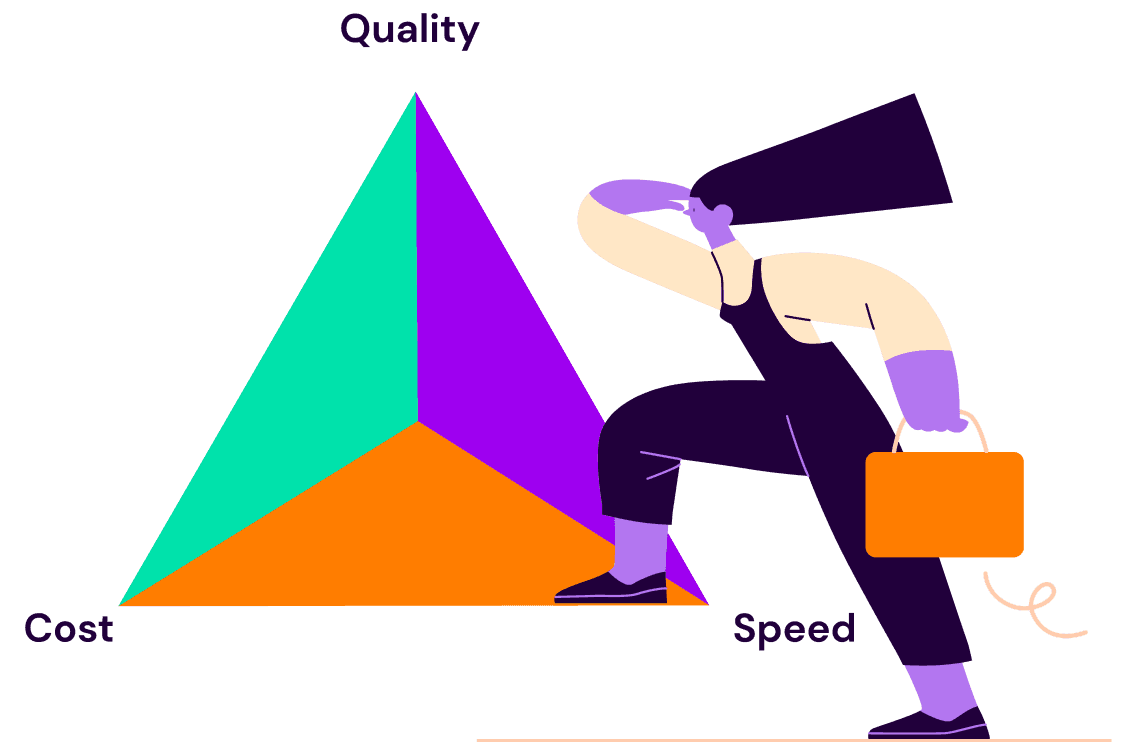
Back to blogs
The recruiter role has been evolving for quite some time. Stiff competition and greater access to sophisticated AI tools have forced organizations to reconsider their definition of success with talent acquisition and retention—and, in turn, how their recruiters affect these outcomes. Talent advisors are needed to support this transition, and recruiters have a prime opportunity to dive right into the role.
Redefining the Role of the Recruiter: From Sourcing Expert to Talent Advisor
Download the reportAhead, we outline what a talent advisor does, the impact the role can have on a business, and what you can do to start transitioning from a recruiter to a trusted talent advisor.
What is a talent advisor?
A talent advisor is a strategist who guides hiring managers and leadership on how to overcome hiring challenges and find the right talent for their organization. They focus on both long-term and short-term successes and hold deep knowledge of hiring trends, the competitive landscape, and existing talent pools. Talent advisors are indispensable in an organization because they understand how to leverage data and technology to shape hiring strategy and find only highly qualified candidates to build successful teams.
Talent advisor vs. recruiter: What’s the difference?
The biggest difference between a talent advisor and a recruiter is that talent advisors influence hiring strategy while recruiters do not. Recruiters have a more reactive role that focuses on filling job openings and taking orders from hiring managers, while talent advisors take on more of a proactive role. They lead talent strategy, and their guidance is valued.
Recruiters are essential in bringing new hires to the organization, but talent advisors take it further. They take a holistic approach to the talent function, aiming to keep new employees at the organization for years to come.
Talent advisor | Recruiter |
|---|---|
Develops long-term talent strategy | Focused only on immediate hiring needs |
Success is measured by long-term KPIs, such as employee retention | Success is measured by short-term KPIs, such as time to fill |
Proactive | Reactive |
Strives to improve processes | Follows existing processes |
Partners with hiring manager to set realistic expectations and guide decisions | Takes orders from hiring managers |
Leverages talent intelligence tools | Uses basic hiring tools |
Talent advisors also use quality data and talent tools to inform their decisions. A recruiter may use surface-level insights, like ATS reports and LinkedIn Recruiter, to report on metrics, but talent advisors go beyond data found in those systems. Instead, they turn to sophisticated tools, like talent intelligence platforms, to help them source hard-to-find talent, gain insight into talent pools, and much more.
What do talent advisors do?
While technology plays a significant role in a talent advisor’s success, the human element is just as important. As you’ll see, talent advisors rely on communication, empathy, and relationship-building—both with candidates and hiring managers—along with data-driven tools to develop strategic roadmaps.
Talent advisors develop a long-term strategy
Talent advisors plan their organization’s hiring strategy, looking ahead to the next one or several years. They work closely with leadership to align on a hiring strategy with the organization’s growth plan and use historical metrics and talent market data to anticipate challenges and plan when specific roles will be needed.
A long-term strategy also requires understanding the organization’s existing talent and how their skills and interests can be nurtured into future roles. For example, talent intelligence software like SeekOut Grow helps assess retention risks and identify skill gaps so that both employees and the organization are set up for success.
Talent advisors drive short-term strategy
Talent advisors also work with hiring managers to develop a short-term strategy when hiring new roles. Both parties discuss details like compensation, qualifications, dealbreakers, goals, and reporting structure.

Suggested Reading: 13 Tips to Upgrade Your Diversity Recruiting Efforts
Talent advisors then analyze the hiring manager’s criteria and determine whether expectations are realistic. They use talent market data and their knowledge of the industry and profession to offer recommendations on finding the right person for the role. The best talent advisors encourage hiring managers to reassess their options when necessary and have the data to back their reasoning.
Talent advisors are experts in their target talent pools
Talent advisors have a wealth of knowledge about their target talent pools. They read industry news and reports to understand the current state of those professions, how technology and innovation are driving change, and the adjacent or transferable skills that can be applied to these roles. This research also helps bring awareness to the challenges and opportunities that could arise when hiring for a specific role.
On top of industry insights, talent advisors get to know the people in these talent pools. They might join talent and professional communities, participate in social media conversations, read surveys, and network with people in the profession. They know what motivates quality talent and use that to guide hiring strategies and interactions.
All this knowledge is synthesized to create ideal talent profiles that include pain points, challenges, and career goals. These profiles help advise hiring managers on what top candidates want in their next job and highlight those desires, needs, and priorities in conversations with talent.
Talent advisors recruit ahead of the need
A long-term talent strategy requires an “always-be-recruiting” mindset. Talent advisors have collaborated with leadership to understand what type of roles need to be filled down the road, so to best prepare, they build a continuous funnel of warm, qualified candidates.

Suggested reading: A Guide to ChatGPT for Recruiters
Talent advisors develop relationships with these candidates and build awareness of their organization. They stay in touch, and when the opportunity arises, talent advisors can start the interview process with these candidates right away. Building a funnel of candidates saves time for all parties involved because it removes the sourcing and screening process—all this work is already done ahead of time.
Talent advisors are highly selective of candidates
Talent advisors build rapport with hiring managers by only bringing them the most qualified candidates. They communicate regularly with hiring managers, asking questions along the way to ensure they have a strong grasp of role requirements. Ideally, the hiring process should move quickly, and talent advisors can help hiring managers avoid wasting time interviewing unqualified candidates by doing the heavy lifting for them.
How to become a talent advisor: Four steps to get started
Transitioning your role will take time and preparation. You’ll have to change how you work and demonstrate to hiring managers that you're capable of more than simply filling roles—you have valuable insights that will help the organization attract the best talent available.
1. Get to know the talent
Start by researching the talent segments you recruit so you understand trends in the profession. Join communities, get active on social media, and build a network so you can create talent profiles and develop relationships with people who could potentially join your organization in the future. Once you’ve gotten to know the talent segment, you can use talent tools to analyze market data and develop deeper insights.
2. Leverage quality data and AI technology
You cannot advise leadership and hiring managers without tools that provide you with quality data. These tools give you access to advanced search capabilities like keywords, Boolean recruiting, filters, and AI matching to surface qualified candidates.
You can also aggregate talent pool data to guide your strategy. Here are examples of candidate data you can use to advise hiring managers:
Number who match the role requirements
Current locations and job titles
Where they work now and where they’ve worked before
Educational background, including majors, degrees, and universities they attended
Hard-to-find backgrounds, including niche experience, unique skills, and licenses
Diversity insights
And get familiar with AI tools that can boost your productivity. SeekOut Assist creates initial candidate searches just by uploading a job description or entering your ideal candidate criteria. It will then draft a personalized outreach message to candidates that you can refine. The time you save on tedious work will free up your schedule for more strategic work.
3. Advise hiring managers
When you have the right tools in place to empower you with a data-driven approach to hiring, you can put everything into action with hiring managers.
For example, if a hiring manager wants someone with eight to 10 years of experience, you can show them how the talent pool expands when you adjust the range to five to seven years. If they insist on a graduate degree, you can show them highly qualified candidates who match all the other role requirements but may not have the same level of formal education.
4. Enable business leaders with insights
To go above and beyond as a talent advisor, begin guiding leadership through valuable industry trends. For example, becoming a skills-based organization is a common goal for many, but the path to getting there can be difficult to navigate.

Suggested reading: How to Get Started with Skills: An Executive Workshop with Josh Bersin
Use talent intelligence tools to understand skills in the market, those amongst competitors, and within your organization. You can compare your employees’ skills to industry pacesetters and identify skills gaps. These insights will help simulate and analyze “build vs. buy" strategies for redeployment, upskilling, and hiring and allow leaders to better crystalize how to address common talent problems as our economy continues to shift.
Using SeekOut to be your organization’s trusted talent advisor
You’re in the middle of an exciting time for recruiters. You can advance your career and become a trusted partner in your organization—and SeekOut can help get you there. Learn more about SeekOut’s human-driven, AI-assisted technology, or get a walk-through of the platform with a free demo.
See us in action
Learn how SeekOut unifies people data to help organizations reach their talent goals
Request a demo




